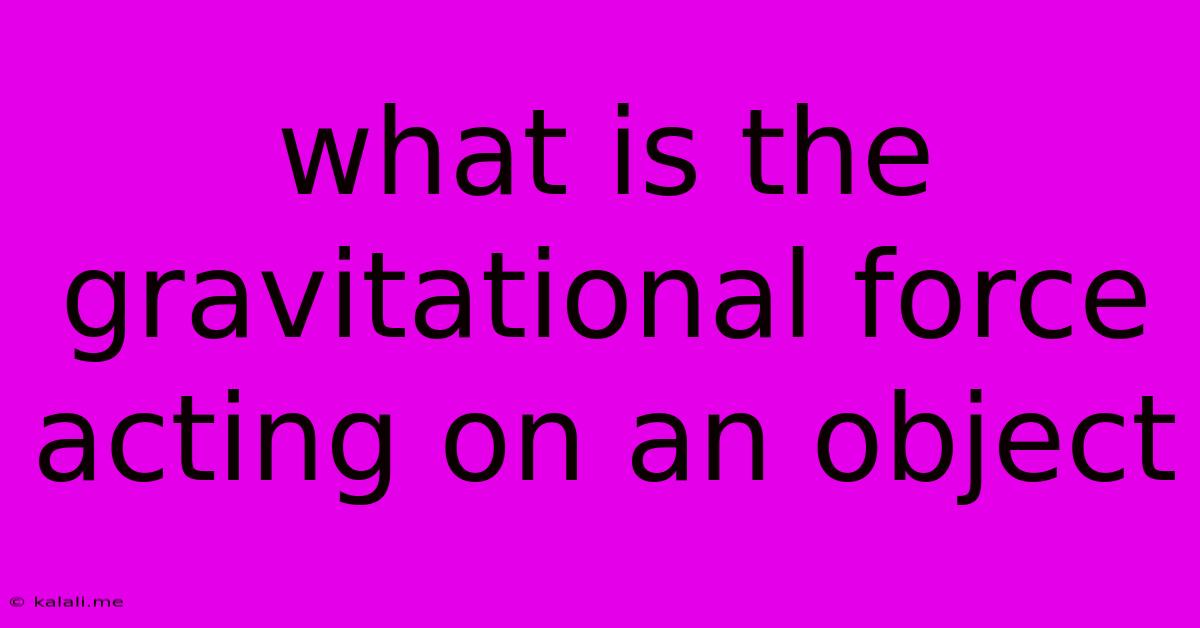What Is The Gravitational Force Acting On An Object
Kalali
Jun 13, 2025 · 3 min read

Table of Contents
What is the Gravitational Force Acting on an Object?
Meta Description: Understand the fundamental force of gravity and how it affects objects, exploring Newton's Law of Universal Gravitation and its implications for weight and the movement of celestial bodies. Learn about mass, gravitational acceleration (g), and how to calculate gravitational force.
Gravity. It's the invisible force that keeps our feet firmly planted on the ground, holds the planets in their orbits, and governs the dance of stars across the cosmos. But what exactly is the gravitational force acting on an object? This article will delve into the physics behind this fundamental force, explaining its workings and impact on the universe, from the smallest apple to the largest galaxy.
Understanding Gravity: A Fundamental Force
Gravity is one of the four fundamental forces of nature, alongside electromagnetism, the strong nuclear force, and the weak nuclear force. Unlike the other forces, gravity is always attractive; it pulls objects towards each other. The strength of this attraction depends on two key factors: mass and distance.
-
Mass: The more massive an object, the stronger its gravitational pull. A planet like Jupiter, with its immense mass, exerts a far greater gravitational force than a small asteroid.
-
Distance: The farther apart two objects are, the weaker the gravitational force between them. This is why the Earth's gravitational pull is weaker on the Moon, which is significantly farther away than objects on Earth's surface.
Newton's Law of Universal Gravitation
Sir Isaac Newton's Law of Universal Gravitation provides a mathematical description of this force. The law states that every particle attracts every other particle in the universe with a force proportional to the product of their masses and inversely proportional to the square of the distance between their centers. This can be expressed as:
F = G * (m1 * m2) / r^2
Where:
- F represents the gravitational force
- G is the gravitational constant (a fundamental constant of nature)
- m1 and m2 are the masses of the two objects
- r is the distance between the centers of the two objects
This formula highlights the importance of both mass and distance in determining the strength of the gravitational force. A small increase in mass can significantly increase the force, while an increase in distance rapidly diminishes it.
Gravitational Acceleration (g) and Weight
On Earth, we experience gravity as weight. This weight is the force with which the Earth pulls us downwards. The acceleration due to gravity, denoted by 'g', is approximately 9.8 m/s² at sea level. This means that, ignoring air resistance, an object falling freely towards the Earth will increase its speed by 9.8 meters per second every second.
Weight (W) is related to mass (m) and gravitational acceleration (g) by the equation:
W = m * g
Gravitational Force Beyond Earth: Celestial Mechanics
Newton's Law of Universal Gravitation is crucial in understanding the motion of celestial bodies. It explains why planets orbit stars, moons orbit planets, and galaxies maintain their structures. The gravitational force between the Sun and Earth, for example, keeps our planet in its elliptical orbit. Variations in gravitational force from other celestial bodies cause subtle perturbations in these orbits.
Conclusion
The gravitational force acting on an object is a fundamental force of nature, dictated by the object's mass and its distance from other massive objects. Understanding Newton's Law of Universal Gravitation provides the framework for explaining everything from the weight of an object on Earth to the complex dynamics of galaxies. Further study into Einstein's theory of General Relativity offers a more nuanced understanding of gravity in extreme conditions like black holes and the expansion of the universe.
Latest Posts
Latest Posts
-
How Are Protists And Bacteria Different
Jun 14, 2025
-
The General Formula For The Alkane Series Is
Jun 14, 2025
-
A Fishbone Chart Is Also Known As A
Jun 14, 2025
-
First Laboratory Of Psychology Was Established By
Jun 14, 2025
-
Which Action Best Illustrates The Process Of Making An Interpretation
Jun 14, 2025
Related Post
Thank you for visiting our website which covers about What Is The Gravitational Force Acting On An Object . We hope the information provided has been useful to you. Feel free to contact us if you have any questions or need further assistance. See you next time and don't miss to bookmark.